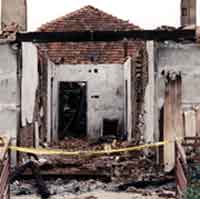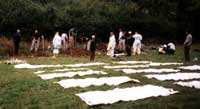|
Kosovo Recovery Efforts
News accounts and preoperational briefings provided advance warning
of the horrors committed by Serbian nationals. However, nothing
prepared investigators and examiners for the devastation present
at what Director Freeh called "the largest crime scene in
history."
The FBI forensic team processed seven
sites in Gjakove, Kosovo, and two sites in the town of Peje from
June 20, 1999 through July 3, 1999. The majority of these sites
were burned houses in which Serbian forces had allegedly murdered
more than 75 individuals. The FBI forensic team recovered seven
bodies, the remains of numerous others, jacketed rifle bullets,
cartridge cases, hand grenade fragments, and evidence for positive
presumptive blood test. Field autopsies conducted on the seven
bodies determined the cause of death to be multiple gunshots
to the head for all seven victims.
A second forensic team was deployed
in response to a United Nations request for the provision of
continued crime scene assistance to the ICTY. This team processed
21 crime scene sites from August 28, 1999 through September 8,
1999. The majority of these multiple gravesites were located
near the town of Glogavac in the Vrbovac Valley, an area approximately
15 km by 6 km in size. Serbian forces allegedly occupied the
main road surrounding this area and began an offensive during
March and April of 1999, during which Albanian villagers hiding
in the woods were captured, tortured, and killed. Those killed
were buried in remote graves by local villagers under the cover
of darkness. More than 250 Albanians are estimated to have been
killed in the Vrbovac area. |


The exhumation of a grave |

FBI forensic recovery efforts |
|
|
The FBI forensic team exhumed the bodies
of 124 victims from 15 sites and processed six "killing"
areas. Field autopsies determined the cause of death to be multiple
gunshots for the majority of the victims, although some, including
a four year-old girl, died from blunt-force trauma. Victims ranged
from a two-year-old boy to a 94-year-old female.
For more information about the FBI
Laboratory's role in the Kosovo investigation, see the Kosovo
section of the FBI Web site. |

